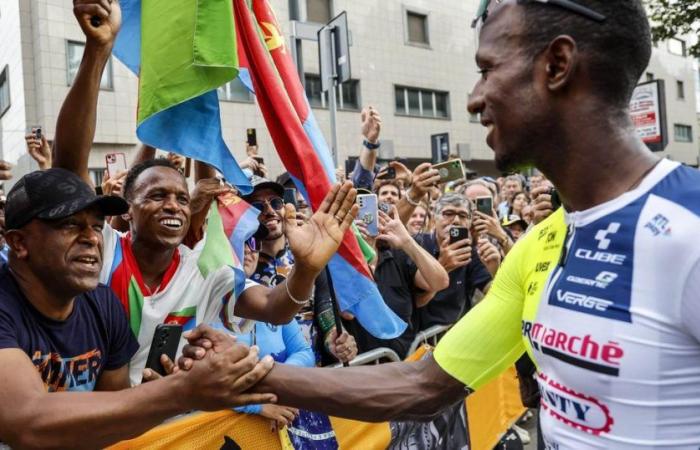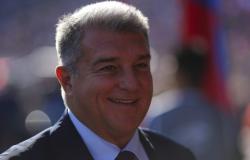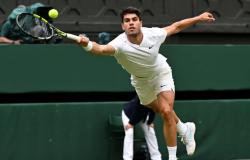DECRYPTION – By winning the 3rd stage of the Tour in a sprint, Biniam Girmay wrote the history of the African continent. A reservoir of talent that is struggling to change gear to make a place in the top positions.
On the heights of the Hamasen plateau, many cyclists pass through Asmara. At an altitude of 2,325 m, the capital of Eritrea was the training ground of Biniam Girmay. Before joining Europe, Intermarché sprinter Wanty Gobert discovered cycling in his country, which is one of the most talented breeding grounds on the continent.
Winner of the 3rd stage of the Tour de France in the streets of Turin, the Eritrean became the first black African to raise his arms on the most beautiful race in the world. A bouquet for history that recalls the feat of his compatriot Daniel Teklehaimanot. The former Cofidis rider became the first African rider to wear a distinctive jersey by sporting the polka dot jersey in 2015. Symbolic records that highlight Eritrea and African cycling.
Read alsoTour de France 2024: Girmay in history, Cavendish has the mask… The tops/flops of the 3rd stage
The locomotive of the little African queen, Eritrea, through its government, has made this sport a real tool of soft power. But the development of cycling comes up against the restrictions of the authoritarian regime, which keeps control over the organization of races and the issuance of passports. A precious sesame for Eritreans who dream of making a career in Europe.
But places are expensive and the absence of a professional African team limits opportunities. Like Girmay, many have turned to the UCI and the development team of the World Cycling Centre (WCC) which trains young riders from developing countries. A bridge that allowed the Asmara native to blossom before making a stint in France at Nikko-Delko-One Provence in 2020.
Girmay, the tree that hides the forest?
Very comfortable in one-day races, the sprinter was quick to confirm at Intermarché by finishing second in the U21 world championships in 2021 like the South African Louis Meintjes before him (2013). Then, he added his name to the list of winners at Ghent Wevelgem in 2022, a few weeks before winning a stage in the Giro d’Italia.
Read alsoTour de France 2024: Girmay affirms that he has “always dreamed” of this victory
Generational talent like Africa has not seen before. Yet, the African continent is still struggling to find a place in the peloton. Since the disappearance of the South African team MTN Qhubeka from the World Tour, which had become the first to represent the continent in 2015, Africa no longer has a team in the first and second divisions.
A lack of structure which weighs on the numbers at the Tour de France since only Louis Meintjes, Ryan Gibbons and Girmay come from the African continent in 2024, compared to six riders in 2015. A development glimpsed at the beginning of the 2010s which is marking time with the disappearance of professional races like the Tropicale Amissa Bongo.
The Gabonese stage race had gained a reputation in the international calendar to prepare for the start of the season while African riders had the opportunity to show themselves, as was the case for the Ethiopian Natnael Berhane in 2014 (1st) and the Eritrean Natnael Tesfatsion in 2020 (3rd). But the political crisis and the August 2023 coup in Gabon forced the organizers to cancel the race. However, hope remains on the continent with several initiatives to promote the development of the little queen.
Planetary meeting in 2025
In South Africa, former cyclist Jean-Pierre Van Zyl is the director of the local branch of the CMC, where he must identify the best U23 riders from all four corners of Africa. “Our team attends the African Continental Championships to identify riders we consider talented, details the former track cyclist on the Team Africa Rising blog. We then discuss it with their national federations and create the opportunity for the riders to come to the training camps in Paarl. [Afrique du Sud, ndlr] (…). We then send them to Switzerland, where they take part in international races.”
A handful of riders who can hope to participate in the Tour de l’Avenir. The most famous stage race on the U21 calendar, through which several future greats have passed (Tadej Pogacar, Jonas Vingegaard or Egan Bernal). Absent from the participating teams, the African nations must rely on the UCI training center to see their best talent shine. This is the opportunity that Ethiopian Welay Berhe was able to seize in 2022 by showing his climbing qualities to catch the eye of Jayco-AlUla.
However, the glass ceiling is still high for African cyclists, who have never managed to make an impact in stage races. No one has done better than Louis Meintjes’ seventh place overall in the 2022 Grande Boucle. An encouraging result, but far from the somewhat optimistic prediction of Jean-Pierre Van Zyl who told Le Monde in 2017: “In five years, there will be a black African rider on the podium of a Grand Tour.” It missed.
There are still many stages to go and the continent will already be able to take advantage of the 2025 road world championship which will take place in Kigali (Rwanda), to continue its growth. A first for Africa and Rwanda, one of the other models of the growth of continental cycling with the hardest race in history (5,803 m of elevation gain). A very demanding course which should not suit Girmay’s legs, who could however present himself there to represent Eritrea and an entire continent.






